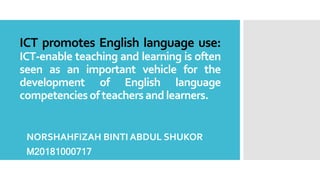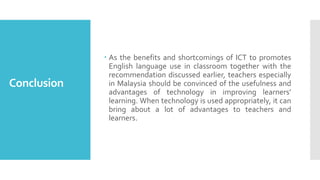The document discusses how learning management systems (LMS) can help link electronic learning materials directly to curricula. LMS are online platforms that allow teachers and students to manage coursework electronically. When used properly, LMS can facilitate blended learning by combining online and face-to-face instruction. However, barriers like lack of educational content aligned with curricula and technical issues can limit LMS effectiveness. Overall, LMS have potential to enhance learning if implemented properly with curriculum integration and educator support.





























![References:
Al-Rahmi,W. M., Alias, N., Othman, M. S., Marin,V. I., &Tur, G. (2018).
A model of factors affecting learning performance through the use of
social media in Malaysian higher education. Computers &
Education, 121, 59-72.
Daud,W. A. A. B.W., Ghani, M.T.A., Bin,A. Z.,Amiruddin, A. A. R., bin
Hassan, A.T., & bintiAbdul, C. A. (2019).The Effectiveness Of E-
Almunawwar As An InteractiveTool For Learning Arabic Language In
Universiti Malaysia Kelantan. E-learning, 3(11).
Edmunds, B., & Hartnett, M. (2014). Using a learning management
system to personalise learning for primary school students. Journal of
Open, Flexible and Distance Learning, 18(1), [11–29].
Ghazal, S., Aldowah, H., Umar, I., & Bervell, B. (2018). Acceptance and
satisfaction of learning management system enabled blended
learning based on a modified DeLone-McLean information system
success model. International Journal of InformationTechnology Project
Management (IJITPM), 9(3), 52-71.
Wai, C. C., & Seng, E. L. K. (2015). Measuring the effectiveness of
blended learning environment: A case study in Malaysia. Education
and InformationTechnologies, 20(3), 429-443.](https://image.slidesharecdn.com/criticalissues-190517050257/85/Critical-issues-30-320.jpg)

